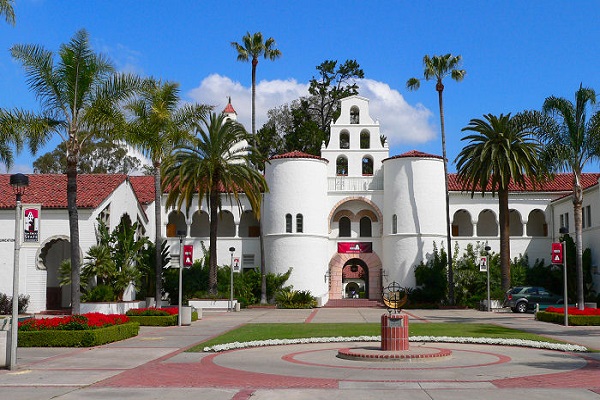San Diego State University Scholars Bag First Place in National Hackathon
San Diego State University students are working to solve pressing public safety issues for crowd control at concerts, sporting events, and other large-scale events.
Team AzTechs, a group of SDSU electrical and computer engineering students, won the grand prize of $10,000 in a competition at the DASSH (Designing Actionable Solutions for a Secure Homeland) Student Design Challenge held February 24-26.
The hackathon competition tasked teams with finding an efficient and safe solution to manage crowds in a public place under a threat.
Team Aztechs’ first-place finish was the product of Tiber “Tito” Hernandez, Jared Acosta, Milan Bujosevic, Chris Choo, Elisha Reece, and DJ Younkin, accompanied by their faculty advisor and engineering associate professor Baris Aksanli.
“Our task at hand was to find an effective and easily communicable means of crowd control that enables crowds to make good decisions in the midst of terror,” explained Reece.
The national competition, organized by the Center for Accelerating Operational Efficiency at Arizona State University in collaboration with the U.S. Department of Homeland Security’s Center for Accelerating Operational Efficiency (CAOE), included 25 teams from more than one dozen U.S. universities. This year, Team AzTechs was the first team from SDSU to compete in this event.
Team AzTechs ultimately focused on Petco Park, the San Diego Padres’ downtown stadium, as an example for their submission video. Together they created a proposal using hardware sensors to detect changes in the nominal states of mass-gathering areas to pinpoint the location of an attack.
“Each member was able to contribute their individual strengths to create a fantastic pitch,” Hernandez said.
40-Hour Adrenaline Rush
Working out of a conference room in the Engineering and Interdisciplinary Sciences building, the team spent over 40 hours and long nights of no sleep to create a plan and compete virtually against schools across the nation.
Tools of the trade included laptops and plenty of whiteboard markers as they sought to create a safe evacuation system through their computer programs.
Team AzTechs applied Dijkstra’s algorithm, designed to map the best plan of escape to an emergency exit for each location.
“Through combining the data of an MMIC radar (a tool used to track movement through a radar) and with media captured from a thermal camera, we were able to develop a platform which analyzes crowd dynamics and generates shortest-path disaster evacuation routes,” said Choo.
Bringing Home the Hardware
The team of six stood together on a Zoom call awaiting the final deliberation à la “American Idol” contestants, erupting in cheers and high fives when the results were announced.
Team AzTechs says the big win was worth the “40+-hour adrenaline rush,” as Choo put it. “This has been one of the most exciting opportunities I’ve had in my time in the College of Engineering. Our results are a testament to the success that comes with curiosity and the right team.”
The students said their knowledge from courses in electrical and computer engineering came in handy during the competition.
“We took what we have learned through our years at SDSU and were able to encapsulate it into a final product that we were all proud of,” said Hernandez, a graduating senior.
Team members said they received vital support from their faculty mentor, who called their work a “remarkable achievement.”
“They designed and implemented an engineering solution, in under 48 hours, and presented it to a jury including DHS leadership to win their well-deserved spot,” Aksanli said.
Most importantly, their contributions hold the potential to contribute to preventing mass casualties within large crowds at future public events.
“We can take this technology and develop it into something that can make a significant impact on mass-gathering areas in the future,” said Hernandez.

